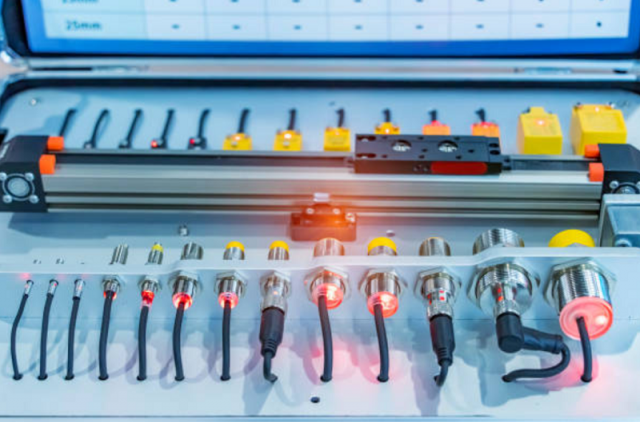The capabilities of non-contact detection for various materials as well as for different applications make capacitive proximity sensors critical in B2B industries such as food processing, packaging, pharmaceuticals, and plastics. These sensors are able to identify both metals and nonmetals, making them vital in industrial automation.
Omchele provides B2B industries with high functioning industrial capacitive proximity sensors. With proper Omchele sensors, businesses are able to detect and monitor the exact level of materials and objects, thereby improving efficiency and reducing system downtimes.
In this article, we discuss the functionalities and benefits, as well as the main points of consideration of capacitive proximity sensors for B2B companies willing to adopt them into automation systems.
Understanding capacitive Proximity Sensors
A capacitive proximity sensor as a sensor that detects targets without making physical contact with them. The contactless detection is done through the alteration of electrical capacitance caused by an object entering within the sensor's field, and the sensor uses an internal capacitor whose dielectric constant alters for the object-based electric field.
Capacitive proximity sensors have a broader range of detection than inductive sensors as they can detect:
- Glass
- Liquids
- Paper
- Wood
- Granular materials
- Plastics
Capacitive sensors have a cylindrical or rectangular form factor which makes them easy to install in compact spaces. Their adjustable sensitivity makes them useful in automated production lines for quick and accurate identification of different materials and shapes.
Industrial Benefits of Proximity Capacitive Sensors
Capacitive proximity sensors have many industrial advantages that heighten their versatility and usefulness:
Detection of Various Materials
With their ability to detect non-conductive materials, these sensors can be used to detect both non-conductive and conductive objects. This detection capability is important for today's complex industrial settings.
No-Contact and Wear-Free Operation
As there is no mechanical contact, the service life is longer and maintenance is reduced. Such features are useful for cleanroom and food-grade environments where contamination is a concern.
Sensitive Adjustments
Fine-tuning via potentiometers or digital settings is supported by most capacitive sensors. This makes detection ranges customizable to the material, object thickness, or installation conditions.
Through-Container Detection
Proximity capacitive sensors can detect liquids or solids within non-metallic containers, like plastic or glass tanks. Therefore, these sensors are appropriate for level detection or filling monitoring in fluid management systems or bottling, as well as in chemical processing.
Compact and Adaptable Design
Capacitive sensors are offered in miniature and standard industrial sizes, easing their integration into new systems or automation projects. There are no significant prerequisites concerning space.
Because of the strong and flexible contactless sensing provided, their use in modern B2B manufacturing environments will meet precision standards. Along with these advantages, Omchele supports and enhances productivity with their precision B2B manufacturing environments.
B2B Application Scenarios for Capacitive Proximity Sensors
Capacitive sensors are extensively utilized across various B2B industries owing to their adaptability and dependability. Below are some of the key use cases:
Liquid and Bulk Material Level Detection
In the Liquid, powder, or granule industries, capacitive proximity sensors are able to gauge the fill levels through the non-metallic walls of the containers. This capacity is very beneficial in the pharmaceutical, food and beverage, or chemical manufacturing industries.
Object Presence and Counting
Small components placed on conveyor or pack belts can be identified using these sensors. They can also be used in counting or verifying the placement of items in automated assembly systems due to their fast response speed.
Detection of Transparent and Opaque Objects
Capacitive sensors are capable of detecting clear glass and might even locate plastic films and translucent containers that are hard to detect using conventional optical sensors. They are beneficial to the glass industries and the plastic molding industries.
Silo and Hopper Monitoring.
In silo areas, capacitive sensors might be put to qualitative use, for instance, monitoring the presence of the material, detecting overflow, and even monitoring the automatic trigger sensors for refilling the silos. The sensors are also useful in dusty and vibrating environments, which are typical of heavy industries.
Cap Detection and Quality Control
In automatic packaging systems, capacitive sensors are used in the detection of caps, seals, or labels affixed to bottles and containers. This also eliminates discrepancies in later stages, and maintains quality of the products.
With growing smart automation and meeting standards of Industry 4.0, a lot of B2B companies prefer using Omchele for capacitive proximity sensors with traditional dependability, and new age functionalities.
Additional Considerations for Choosing a Capacitive Proximity Sensor
Beyond basic integration of industrial capacitive sensors, there are specific criteria that engineering teams and procurement departments should analyze.
Sensing Distance versus Dielectrics
The sensing distance is affected by the dielectric constant of the material being detected. Higher dielectric materials such as water or glass are easier to sense. Lower ones such as paper have to be more sensitive or be closer to the sensor.
Material Selection and Environmental Ratings
A sensor's physical protective features such as weather tightness to water, dust, dirt, oil and even corrosive chemicals, as well as the Stainless Steel PBT housing should fall under protective standards IP65 to IP67.
Installation Procedures
The sensor size and shape must match the installation space. A description, argument or image could help portray the idea of flush as well as non flush mounting and its purpose to the reader.
Sensing Output and Signal Integration
The sensor output should be aligned to the controller input, be it NPN, PNP, relay or even IO-Link. Applications that need distance measuring sensors are better off with analog outputs.
Digital Capabilities and Sensitivity Settings
Remote setting and teach-in options provide more control at differing sensor placement contexts. This feature provides the possibility of changes within the sensor's vicinity without the need for manual removal or recalibration.
In prioritizing these capacitive proximity sensors with the specified technical features, B2B firms mitigate risks of long-term underperformance, automate their processes with greater efficiency, and lower their error rates.
Reasons Why Omchele is a Preferred Supplier for Industrial Sensor Solutions
Omchele is widely recognized as a dependable and resourceful supplier for proximity sensors as they have served industrial clients across the globe. Omchele capacitive sensors are tailored for B2B markets requiring automation with precision, velocity, and adaptability.
In this case, these reasons explain why Omchele is the preferred sensor supplier for many companies:
- Extensive Product Range: Omchele's portfolio includes miniature sensors suited for small spaces, long-range sensors for tank monitoring, and many more to serve industrial needs.
- Global Accessibility: The brand's support in multiple languages and cross-border sales and distribution enables customers to receive timely delivery and after sales services.
- Customization Options: Omchele collaborates with proprietary system OEM customers to provide sensing components designed for effortless integration.
- Advanced Technology: Omchele sensors are able to IO-Link and other interface integrations, and their sensitivity can be programmed, therefore, they are programmable as smart factory sensor technology demands.
- Industrial Durability: Their sensors have IP ratings, protective casing, and long lasting performance, which allows them to withstand extreme environments.
With Omchele's capacitive proximity sensors, manufacturers and automation system integrators receive an unrivaled sensing reliability and innovation. The sensors provide and unmatched sensing solution and guarantee innovation for the automation and manufacturing industries.more details here:https://www.omchele.com/fr/proximity-sensors/capacitive-proximity-sensors/
To summarize, capacitive proximity sensors have become a key part of contemporary automation solutions as they provide accurate and non-contact detection for a large variety of materials and environments. Their non-intrusive design, multi-material compatibility, and tremendous adaptability will greatly benefit B2B customers focused on efficiency and uniformity in operations.
Business objectives, whether to monitor liquids, confirm the correct positioning of components or improve safety on production lines, Omchele has tailored scaling sensor solutions for each of them.






